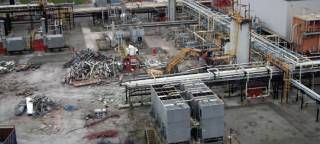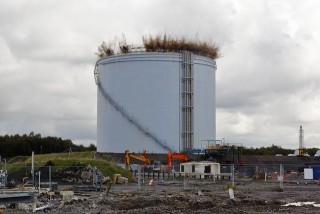Grangemouth-based decommissioning specialist Masterton is dismantling four liquefied natural gas (LNG) tanks and associated process plant at the Heath Farm Lane storage facility at Partington, Manchester.
The £4m contract for National Grid is the first LNG demolition project of its kind in Europe and is calling upon a number of pioneering techniques. Work started on the 195,000m² site with extensive testing and preparation to ensure that the site was fully purged of any residual risks. Masterton’s team of 12 used hot cutting techniques and demolition excavators with shears to remove low-level pipe work and vessels from the vaporisation and liquefaction plant. It then turned its attention to the four LNG gas tanks that dominate the skyline across the site.
Standing 45m high and with a circumference of 135m, the double-skinned tanks had each been used to store more than 21,000 tonnes of LNG at temperatures of -160oC. Very different in construction to traditional gas holders, these tall steel tank-within-a-tank structures were designed in the 1970s to store the highly volatile natural resource safely in its liquid state. With solid sides, the tanks have steeply sloping arched roofs supported by a series of arch beams. On each tank, the roof alone weighs some 150 tonnes.
Masterton project manager Matt Harvey explains: “By liquefying the natural gas here at Partington, National Grid was able to store far larger quantities. The liquefaction process refrigerates the gas at extremely low temperatures and therefore the tanks were designed to act effectively as giant Thermos flasks.
They are doubleskinned with perlite insulation between the inner and outer skin. “Dismantling the steep roofs of the tanks was initially a concern; the safety of our men would have been compromised by working at such heights as the very heavy structure became unstable. However, using our extensive industrial demolition and structural engineering expertise, we designed method that would use explosive charges to cut through the outer steel roof and ensure it dropped safely to the ground within the body of the gas holder whilst all our operatives were safely beyond the exclusion zone.”

Following rigorous testing, the 60 steel supporting roof beams of the first holder were exposed. Fifteen of them were then preweakened with sit cuts and the other 45 had explosives charges inserted. The sit cuts were
concentrated to one side of the tower to induce a rotation in the roof section, ensuring that it collapsed to the ground within the structure and would not get lodged within the tank lining. Two of the other tanks have 80 roof beams each, rather than 60. These have explosives charges applied to 60 beams and the remaining 20 beams have sit cuts. The first tank roof was blasted at noon on Thursday 4th October, and the second three weeks later. The final two tanks are scheduled to have their roofs blown this month. In each case, after the roof is brought down using explosives, the compression ring on each tank is split and then pulled down using wire rope. The compression rings are 40mm thick steel plate and effectively tie the top of the tank together.
Once the compression ring is down, Masterton uses long-reach machines with plate shears to dismantle the tank sides. The sides are 6mm at the top and increase to 18mm at the bottom. The inner tanks are sheared at the same time. National Grid Projects commissioning manager Frank Harries was happy to see the explosive demolition all go smoothly. “Thanks to the professionalism of everyone in the highly qualified Masterton team, all went according to plan,” he says. “Their pioneering approach has been very successful indeed with the tank roof collapsing in on the structure perfectly. We have now established a very safe and effective way of tackling these difficult and unusual structures.”

Masterton, which is part of the Essex-based Blackwell Group, is continuing with the demolition of the tanks and will also bring down a 30m-high Solexol absorber column. This column was used to absorb contaminants during the gas liquefaction process. It will be pre-weakened and pulled over using wire rope, before being cut into sections using excavator-mounted shears. The contract is due to be completed by the end of January 2013.
See page 23 & 24 in The Construction Index magazine. http://epublishing.theconstructionindex.co.uk/magazine/november2012
Got a story? Email news@theconstructionindex.co.uk



